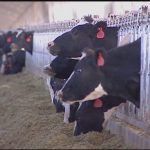
The Class III price finished 2018 with an average of $14.61 — the lowest average level since 2010. The December price is down 66 cents from November and $1.66 lower than December 2017.
While milk prices were bleak to end the year, UW-Madison dairy analysts Bob Cropp and Mark Stephenson are optimistic that 2019 will be better, with only weak increases in milk production forecast and, hopefully, a resolution to trade issues with Mexico and China, which both are big buyers of U.S. dairy products.
In their late-December dairy market podcast, Stephenson said butter and cheese stocks ended 2018 at a relatively high level, keeping a lid on prices.
“Normally, we don’t see cheese inventories growing this time of year,” he said.
Where milk prices go from here hinges a lot on U.S. milk production, which the U.S. Department of Agriculture expects to grow by just 1.3 percent this year. Most of the recent growth has taken place in the western U.S.
“I could see it less than that, even,” Cropp said of growth predictions.
Domestic dairy sales are expected to continue to be positive, except for fluid milk, he and Stephenson said, so a lot depends on the export side of the equation. World milk production has slowed and the dollar is a little stronger, but unless the U.S. resolves lingering trade concerns with China and Mexico, particularly, exports will be down, weighing heavily on farm-level milk prices.
While some market analysts had called for Class III to be near $16 by the end of 2018, that didn’t pan out, Cropp said. He expects prices to move higher in 2019, starting just under $15 in January, moving into the $15s by the second quarter and averaging close to $16 for the year.
But “farmers need more than a dollar improvement,” he said.
After getting off to a slow start due to the holidays, Class III milk finished strong the last week in December, according to the weekly Stewart-Peterson commodity report.
“We saw volume re-enter the market as trading volume in the January 2019 contract surpassed all of 2019 contract volume,” the report stated. “The majority of the volume … came after the spot cheese session that pushed the block/barrel average 3.25 cents higher on the day. This move was driven by Cheddar blocks in a 6-cent up day on one load traded. … The move in the spot market spurred the January and February Class III contracts higher. January gained 18 cents to finish the week at $14.41 and February gained 22 cents to finish the week at $14.67.”

























